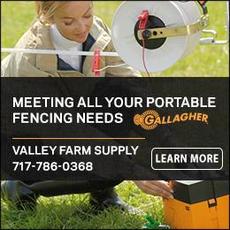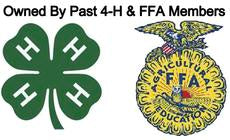Traditionally, usage of land has been demarcated by fences - often in combination with geographical features such as rivers and impassable rocky outcrops, or other prominent land marks such as drystone walls and tree lines. Fences are also associated with land use and livestock management - either precluding access by livestock to cultivated crops or improving utilization of veld and pastures.
Until relatively recently all farm fences were of barbed wire, supported by iron standards and droppers, between substantial straining posts. Fences of this kind are both a physical and psychological barrier to livestock and intruders. A major drawback of "conventional" fencing of this type is the expense involved: the cost in April 2000 for a 'standard' 5 strand barbed wire fence was R4 033 per kilometre.
Recent advances in (electronic) technology have ensured that electric fences now offer a viable option to barbed wire fences in most situations - with the added advantages of adaptability and significantly improved cost effectiveness.
Principle of electric fencing
Electric fencing is based on a simple principle: Energisers have two terminals, demarcated "Fence" and "Earth/Ground." A thin, insulated wire is charged with electric energy from the "Fence" terminal. A second, thin wire is connected to an earth. Whoever/whatever closes the circuit between the two terminals receives a substantial, safe (low amperage/high voltage) electric shock.
Equipment and construction
The "heart" of the electric fence is the energiser. Most modern energisers generate approximately 5 000 volts. The ability to sustain this charge depends on the capacity (measured in joules) of the energiser. Small energisers (1.0 joule) are adequate for powering small networks (15 km) of fencing and strip grazing applications. Large energisers (20 joules) will power networks of up to 175 km under normal conditions. The most effective energisers require either a 12 or 24 volt wet-cell (tractor type) battery, or A/C mains as power source. Specialised power sources such as solar or dry-cell (torch) battery models are less common.
Careful selection of an appropriate energiser is essential. Consideration should be given to the purpose of the network (security and/or grazing management), the size of the network, the type of threat/animal to be controlled, the ease of maintenance of the energiser, and the proven service record and reliability of the supplier.
Insulator quality is of paramount importance in electric fencing. The purpose of insulators is to ensure that the full amount of energy discharged into the wire is channelled through the intruder/animal when the circuit is closed. Insulators manufactured from fibreglass-type compounds, treated with fire-retardants and ultraviolet radiation stabilizers during the manufacturing process are the most reliable and cost effective (some are still performing perfectly after 20 years of continuous use). High density polyethylene insulators tend to fail when subjected to fire, and become brittle after a number of years' exposure to sunlight. Porcelain insulators are highly susceptible to physical vandalism. Used and discarded plastic water piping and/or rubber inner tubes are not at all suited as insulators.
The "earth" section of the circuit is as important as the "live" or "insulated" section. Furthermore, the larger the output capacity of the energiser, the larger the surface area of the earth-pegs required. Ideally, earth-pegs should be sited in areas which remain permanently moist (for example in close proximity to a gutter down-pipe, down-slope from a drain, near a small stream or natural spring). A single earth-peg made of 20 mm galvanised water-pipe driven vertically into moist soil to a depth of one metre is adequate for a small energiser (1.0 joule output capacity). At least 20 such earth pegs used in a similar manner are necessary for a large (20 joule output) energiser. Clearly, all earth pegs must be interconnected with each other and the earth terminal of the energiser. Stainless steel or copper piping ensures even better earthing. With regard to the actual fencing used, fully galvanised baling wire (2.5 mm diameter) is the most practical for temporary (6 months or less) and semi-permanent (less than 2 years) use. High-strain, steel wire (2.0 x 2.6 mm) is recommended for permanent use (2 to 10 years). Purpose-made nylon wire, braided with 6 strands of stainless steel wire, is recommended for strip-grazing purposes, or those occasions where a network will be used for 3 - 4 weeks at a time and then removed. It should be noted that different soil types have different (electric) conductivities. This has a direct bearing on the fencing configuration used in any situation.
On heavy, damp, clays (and areas under irrigation) all wires in the fence should be "live". In dry areas, on sandy soils, or in areas where the soil surface is covered by dry, non-conductive material, wires should be alternatively "live" and "earth".
When constructing the fence the following basic principles should be adhered to:
- Fence strands should at all times be parallel to the soil surface and to each other.
- The distance between strands should be such that the animal/intruder chooses to retire from, rather than proceed through, the fence once shocked.
- Fence voltage should be maintained above 3 000 volts for wooled sheep, 2 000 volts for cattle and goats and 1 500 volts for thin skinned animals such as horses and pigs.
The fence standards on relatively flat topography can be as far apart as 50 metres with droppers in-between at 15 metre intervals. For control of domestic livestock (cattle, calves, sheep, goats (and even dogs!)) it is seldom necessary to have a fence taller than 900 mm above the ground. Security and game fences should be 2 000 mm tall. Ideal strand spacings within the fence are shown in the Table.
Problems and fault-finding
Problems with electric fencing do occur. However, if good fencing principles and techniques are followed when the fence is constructed, these problems can be minimized. The most common faults include:
- Voltage "leakages" arising from:
-
Dead shorts - as a result of a direct connection to ground/earth
-
Vegetation - high volume of actively growing, lush vegetation contacting live wires
-
Cracked or weathered insulators giving rise to cumulative leakage
-
Poor earth system:
-
Inadequate surface area of earth peg(s)
-
Drying of soil around the earth peg(s)
-
Loose or corroded connections to the earth section of the network.
-
Loose or corroded connections in the "fence" section of the network. The use of "reef" knots or "figure eight" knots (in preference to double loops) and use of galvanised line clamps reduce the incidence of these possibilities.
-
Faulty energisers - a problem which may occur after electric storms and lightening strikes on the fence.
A number of desirable and useful accessories are available for use in electric fencing. However, four items are deemed to be essential. These are a digital volt meter (for accurate measurement of fence performance), cut out switches, a lightening diverter and an alarm linked to a warning mechanism (siren, buzzer or flashing light). The alarm should be placed on the end of the fence furthest away from the energiser and is used to warn the operator when the output of the fence between the energiser and end of the fence drops below a predetermined level. In the event of a voltage drop (reasons may include a cut fence; fence 'shorted out' by an animal/tree branch/intruder; vegetative material causing leakage) voltage readings can be taken and the cause identified. Cut out switches significantly reduce the amount of "down-time" lost in tracing and rectifying faults. These switches are placed at strategic points in the network and are used to isolate individual sections when fault-finding.
Conclusion
Electric fencing presents a viable option to conventional barbed wire or prefabricated fencing. Provided it is properly constructed and well maintained, it is more adaptable, convenient and cost effective than conventional fencing.
Strand spacings for electric fences
| Cattle and calves |
3 strands |
290; 600 and 900 mm above ground |
Sheep and lambs
(even topography) |
4 strands |
150; 335; 600 and 900 mm above ground |
Sheep, lambs
(uneven topography)
goats |
4 strands |
150; 290; 900 mm above ground |
| Pigs |
3 strands |
150; 335; 600 mm above ground |
| * Security and Game |
14 strands with 1 off-set |
150 mm above ground and 150 mm between successive strands
Off-set support on "top" and "3rd from top" strand |
* Note that for use in security applications all strands of similar charge (polarity) are connected in "series" and not: parallel" as is the case with grazing control fences.





